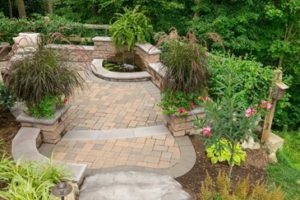Lush gardens are a wonder to behold. We all love seeing those rows of plants spring up and watch veggies grow big, not to mention seeing the joyous colors of the season in the delicate flower petals we’re lucky enough to enjoy.
All of this takes work, of course, but for many gardening is a toil of love. However, even if one loves tending to their garden, some tasks can be grueling for the gardener and the plants. Watering is one of those landscaping tasks that can take up more time and money than a gardener predicts.

Sprinklers and hand-watering seem to be the irrigation choice of every movie character ever seen. The opening shots of a “typical suburban home in summer” scene tends to include a person watering the outdoor greenery with a hose. And who could forget the ill-timed sprinkling system in Caddyshack? As universal as these solutions may seem on the big screen, they aren’t the only ways to irrigate your landscape, and they definitely are not the most efficient.


Drip irrigation, sometimes called “micro-irrigation” after the tiny water droplets it disperses, is a pipe or hose system with parts called emitters that distribute the water directly to the soil and roots around a plant. The simplest version is a garden hose manufactured with small holes that allow water to seep or lightly spray out. Drip irrigation can save up to 50% of the water typically spent using hand-watering or sprinklers. Many more benefits exist for the homeowner who installs a micro-irrigation system.
A drip irrigation system:
• is ready-to-install by the home gardener
• can be found at many gardening supply stores
• maintains a good balance of air and water
• is easily adapted to odd-shaped landscapes
• has over a 90% water efficiency rate (sprinklers hit 50-70%)
• may be exempt from restrictions in a water-restriction zone
• minimizes water runoff by inserting water into the soil
• avoids over-watering, which can damage and kill plants
• does not damage delicate new growth
• can be used in containers and raised beds
• can be automated with an inexpensive timer found in supply stores
• is expandable – can be added onto as the garden gets bigger

Parts of a drip irrigation system (in order from the pressurized water source):
• Spigot
• Timer and/or filter, usually attached to spigot
• Pressure control valve
• Distribution lines (the “pipes”)
• Control and safety valves along the lines
• Connectors (if necessary)
• Drippers or emitters (near the plants)
• Depending on the type of system installed, the timer, valves and emitters can all be set to work and shut off automatically or they can be controlled manually. Some drip irrigation kits come with controllers for the entire system.
Pitfalls
• A bit of gardening logic is required. Emitters must be placed near the roots of the plants. If the emitters are spaced too widely apart, some of the seeds and roots won’t be watered. Knowing the spacing of the rows will assist in emitter placement.
• Unlike sprinklers, evidence of a drip irrigation system’s work isn’t always so obvious. It can be hard to know if the system is doing its job well. Occasional checks of the soil may be necessary.
• Filters only work so well. Minerals in the water may collect at different parts of the system. Maintenance includes checking for clogs and mineral buildup. Filtering the water does help avoid clogs. Look for a system that has self-cleaning emitters.
• Tubes that sit above ground are always a tripping hazard. Don’t run drip irrigators over any pathway or walkway, and avoid laying tubing over any “desire paths” in the landscape. Burying the length of distribution line that must traverse a path is worth the time and effort.
Try it this year
Don’t be intimidated. A drip-irrigation system, while not the stuff of movies, is still just as glamorous. And it will be easier to install than you may think. Most kits sold come with detailed instructions for the homeowner to follow, but a person new to drip-irrigation can find more information online. Saving on your water bill also helps save the environment. And that will give us all many more years of gardening to come.